Understanding Time Delays in Ashtanga Yoga: A Systems Thinking Perspective
Think quick: What’s the most unsatisfying answer I give both on the road and at home?
“More Practice.“
It’s just so frustrating and inconvenient. And true. It’s an inconvenient truth and an annoying reality when dealing with a system. It’s safe to say I’ve struggled with them. In Ashtanga Yoga, a misidentification of the impermanent as permanent can lead to our suffering (click here to enroll in my free Klesha’s Course, over at Ashtanga Tech), and unfortunately, Time Delays have a way of creating cognitive biases around time.
In systems theory, a time delay refers to the gap between an action and its resulting effect. Applying this to Ashtanga Yoga, the diligent practice of poses and sequences (the action) doesn’t yield immediate mastery or benefits (the effect). The visible and felt progress, such as improved flexibility or mental clarity, emerges only after consistent practice over time, embodying a time delay.
Understanding this concept encourages practitioners to approach their practice with patience and persistence, acknowledging that the fruits of their efforts will manifest gradually and subtly.
So, what I really mean when I say “more practice” is “don’t get bent out of shape.”
Sometimes things happen overnight, but of course it just seems that way. Ashtanga Yoga is not merely a physical endeavor but a holistic journey, intertwining the physical, mental, and emotional spheres of the practitioner. The subtle and gradual transformation of the body, paired with the mind’s adaptation to the mental disciplines of yoga, requires a gentle, patient, and persistent approach. This dual adaptation, while seemingly straightforward, is layered with complexities that become more apparent and enriched as one delves deeper into the practice.
Diagram: Practitioner’s Progress and Challenges
Practice Consistency → Physical Strength:
- The Loop: Consistent practice is fundamental in gradually building physical strength, a crucial component in mastering asanas and progressing through the series.
- In Practice: Your regular encounters with the mat, moving through each pose, naturally enhance muscle development and endurance, enabling you to hold asanas with stability and ease.
2. Physical Strength → Flexibility:
- The Loop: While strength provides stability, it also plays a vital role in enhancing flexibility by allowing you to move into postures with control and safety.
- In Practice: The strength developed in areas like your core, legs, and arms supports your ability to explore deeper stretches and maintain alignment, safeguarding against injury and facilitating improved flexibility.
3. Flexibility → Mental Focus:
- The Loop: As you navigate through the physical aspect of flexibility, there’s a subtle enhancement in mental focus, stemming from the mindful engagement of muscles and breath.
- In Practice: The conscious elongation and relaxation of muscles in flexibility-focused asanas require a harmonious synchronization of breath and movement, naturally honing your mental focus and presence.
4. Mental Focus → Challenges:
- The Loop: A sharpened mental focus, cultivated through practice, becomes a tool to navigate through challenges, whether they be complex asanas or mental hurdles.
- In Practice: The mental clarity and focus developed through consistent practice equip you with the resilience and perceptiveness to approach challenges with a balanced and introspective mindset.
5. Challenges → Practice Consistency:
- The Loop: Encountering challenges is an integral part of the journey, and how we engage with them can either deter or fuel our practice consistency.
- In Practice: Challenges, both on and off the mat, can be embraced as opportunities for growth, learning, and exploration, potentially inspiring a deeper, more consistent practice as we seek to understand and work through them.
The Continuous Loop:
- The cycle doesn’t end here; it’s a perpetual loop. The consistency in practice, further enhanced by navigating through challenges, continues to build physical strength, promote flexibility, and sharpen mental focus, each aspect feeding into the next, creating an ongoing cycle of development and discovery.
In the realm of Ashtanga Yoga, this causal loop becomes a mirror, reflecting our internal and external journeys, where the physical and mental are intimately intertwined. Each step forward brings new challenges and, with them, opportunities for deeper understanding and growth. May your practice, through its ebbs and flows, be a continuous source of exploration, strength, and serenity.
The Garden Ecosystem and Time Delays
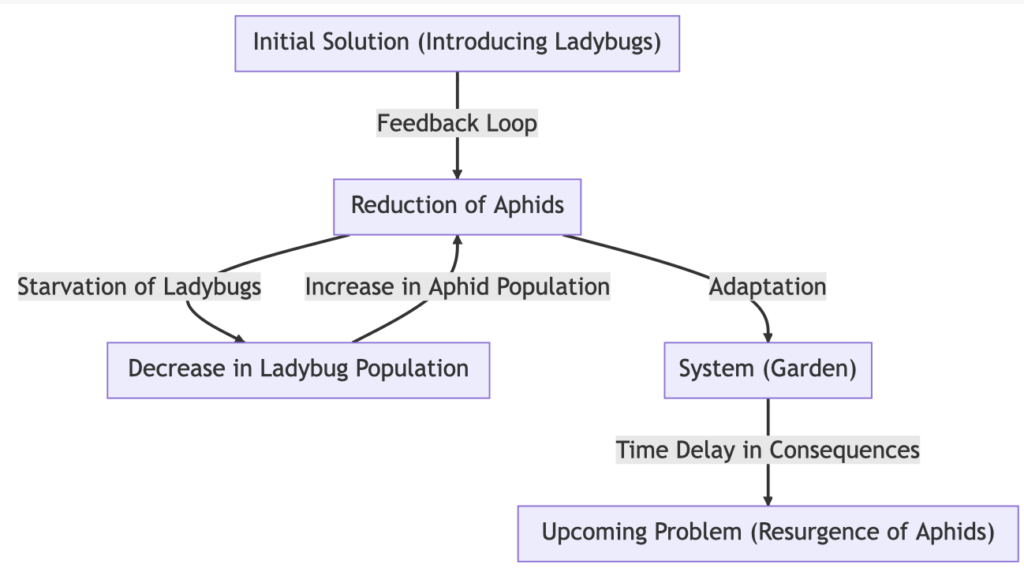
Imagine you have a beautiful garden filled with a variety of plants, flowers, and a small pond. One day, you notice an influx of aphids (small insects) damaging your plants. In a rush to save your garden, you introduce ladybugs, natural predators of aphids, to quickly control the situation.
Immediate Response:
- Observation: Initially, you observe a significant reduction in the aphid population, and your plants start to recover.
- Assumption: You assume that introducing ladybugs immediately resolved the issue.
Hidden Time Delay:
- Repercussion: After a few weeks, you notice that the plants are again showing signs of distress, but this time, it’s not due to aphids. The ladybugs, having reduced the aphid population, are now starving due to a lack of sufficient food.
- Secondary Issue: The starving ladybugs are migrating away or perishing, and without their presence, a new generation of aphids begins to grow unchecked, causing a resurgence of the initial problem after a delay.
Systems Theory Perspective:
- Feedback Loop: The initial solution (introducing ladybugs) created a feedback loop. The reduction of aphids led to the starvation of ladybugs, which in turn allowed the aphid population to increase again after a certain time delay.
- Adaptation: The system (garden) tried to adapt to the new conditions, but the time delay in the consequences of the initial action (introducing ladybugs) masked the upcoming problem (resurgence of aphids).
Relating to Ashtanga Yoga Practice:
- Immediate Solution vs. Long-term Consequence: Just like introducing ladybugs seemed like an immediate solution, a yoga practitioner might seek quick progress by pushing their limits. However, the time delay in experiencing the consequences, such as potential injury or burnout, might initially mask the detrimental impact of such actions.
- Understanding the System: A seasoned gardener might predict the potential issues with introducing a predator, just like an experienced yoga teacher understands the importance of gradual progression and respects the time delays inherent in mastering yoga practices.
Lessons Learned:
- Holistic Understanding: A thorough understanding of the system (whether it be a garden ecosystem or a yoga practice) is crucial to predict and comprehend the time delays and the long-term consequences of immediate actions.
- Balanced Approach: A balanced approach, considering both immediate needs and future consequences, is vital in managing systems effectively and ensuring sustainable progress in yoga practice. This could also be call to reach out to a master gardener, or teacher (I’d love to help!)
This example illustrates how a seemingly immediate solution can have delayed consequences that might exacerbate the original problem. It emphasizes the importance of understanding and respecting time delays in systems, whether dealing with an ecosystem or progressing in a disciplined practice like Ashtanga yoga. It also speaks to the value of a senior teacher.
Who Struggles with Time Delays?
People from various walks of life and with different personality traits might struggle with time delays, especially in contexts like learning, practicing a skill, or adapting to changes. Here are a few examples:
Impatient Individuals: Those who seek instant gratification or quick results might find it challenging to navigate through processes that inherently involve time delays.
Beginners or Novices: Individuals new to a particular field or practice might struggle with time delays due to a lack of understanding of the inherent learning curve or progression timeline.
High-Achievers and Perfectionists: People who are used to excelling and achieving might find time delays frustrating, especially if they are accustomed to quick mastery or progression in other areas.
Competitive Personalities: Those with a competitive streak might find time delays challenging, especially if they perceive others as progressing more rapidly or achieving more in the same timeframe.
Individuals with Fixed Mindsets: People with a fixed mindset, who believe that abilities and intelligence are static and unchangeable, might struggle with time delays as they may interpret them as a reflection of their inherent capabilities.
People in Stressful or Urgent Situations: In scenarios where there is pressure or urgency, individuals might find it particularly challenging to navigate through processes that involve time delays, as the delays might exacerbate stress or tension.
Individuals Lacking Confidence: Those who lack confidence in their abilities might perceive time delays as a confirmation of their self-doubt, interpreting them as a sign of their inability rather than as a natural part of the process.
People Unfamiliar with Systems Theory or Similar Concepts: Individuals who lack understanding or awareness of concepts like feedback loops, adaptation, and time delays in systems might struggle to navigate and manage processes that inherently involve such delays.
Understanding and managing time delays effectively often involve developing patience, a growth mindset, and a strategic approach that acknowledges and respects the natural progression and learning curves involved in various processes and practices.
Individuals with neurodevelopmental conditions like Autism Spectrum Disorder (ASD) and Attention-Deficit/Hyperactivity Disorder (ADHD) might experience unique challenges and perspectives when dealing with time delays, due to the distinct ways in which they process information, manage attention, and engage with their environments.
Autism Spectrum Disorder (ASD):
Sensitivity to Change: Some individuals with autism may struggle with changes in routine or unexpected delays due to their preference for consistency and predictability.
Processing Speed: Depending on the individual, there might be variations in processing speed, which could influence how they manage and perceive time delays.
Focus and Special Interests: On the other hand, if an activity or subject aligns with their special interests, they might exhibit remarkable patience and focus, dedicating substantial time and attention without evident frustration regarding progress.
Attention-Deficit/Hyperactivity Disorder (ADHD):
Impulsivity: Impulsivity, a common characteristic of ADHD, might make managing time delays challenging due to a natural inclination towards immediate action and results.
Attention Management: Maintaining consistent focus over extended periods, especially in the face of delays or gradual progress, might be challenging.
Frustration Tolerance: Some individuals with ADHD might experience lower frustration tolerance, making the navigation of processes with inherent time delays potentially challenging and requiring additional support and strategies.
Other Neurodevelopmental or Psychological Conditions:
Anxiety Disorders: Individuals with anxiety might struggle with time delays due to worry about future outcomes or potential changes.
Learning Disabilities: Depending on the nature of the disability, time delays in learning or skill acquisition might present unique challenges or require specialized approaches and interventions.
It’s crucial to note that there is substantial variability within these conditions, and individuals might experience these aspects in diverse ways. Tailoring strategies, support, and interventions to the unique needs, strengths, and challenges of each individual is pivotal in facilitating their navigation through processes involving time delays, ensuring that they are empowered and supported in their journeys.
How Does Ashtanga Help?
When we begin to monitor adaptation, we can begin to see what is causing that adaptation. These feedback loops emerge as pivotal elements in yoga practice. These loops, manifesting as physical sensations, emotional responses, and guidance from a teacher, serve as subtle navigators, steering practitioners toward alignment and mastery. Both intrinsic and extrinsic feedback mechanisms collaboratively guide the practitioner, helping them navigate challenges and facilitating progression in their practice.
Adaptation, as explored in systems theory, speaks to the ability of a system to adjust and maintain stability amidst changing conditions. In Ashtanga Yoga, adaptation silently permeates every pose, sequence, and level, becoming a silent yet pervasive companion of the practitioner. This adaptation extends beyond the physical, ensuring progression is not only visible in the mastery of poses but also experienced as a deepening mental clarity and emotional equilibrium.
The problem with time delays, of course, is that they take time. Consider a garden ecosystem: aphids can eat and destory the plants. Introducing ladybugs to control aphids seems like an immediate solution but brings about delayed consequences, such as a resurgence of aphids following the ladybugs’ migration due to starvation. This illustrates the importance of understanding and respecting time delays in systems, whether dealing with an ecosystem or progressing in a disciplined practice like Ashtanga yoga. In the context of yoga practice, understanding the system and respecting the time delays inherent in mastering yoga practices is crucial to predict and comprehend the time delays and the long-term consequences of immediate actions.
Some Common Complaints
Embarking on the path of Ashtanga Yoga can sometimes mirror the perplexity of stepping into a new role without a clear toolkit to navigate its complexities. The practice, with its intricate poses and philosophical depths, often demands a blend of physical capability, mental stability, and spiritual connectivity that may seem daunting to a novice. It’s akin to a paradox where the practice itself is the tool to build proficiency, yet that very proficiency seems requisite to delve deeper into the practice. This might manifest as a tangible frustration, a feeling of being anchored in a sea of unknowns, where the depth and vastness of Ashtanga Yoga are visible, yet seemingly unattainable due to the current limitations of understanding and skill.
Ashtanga Yoga invites practitioners into a journey that is less about arriving at a destination and more about a continuous process of learning, unlearning, and relearning. It’s a pathway that transcends into every facet of one’s life, weaving a tapestry that is rich, vibrant, and perpetually evolving. The essence of this ancient practice is not encapsulated in the perfection of a pose but is found in the gradual, consistent, and dedicated journey towards mastery. Mastery of what? The senses. The mind. It’s not a small feat.
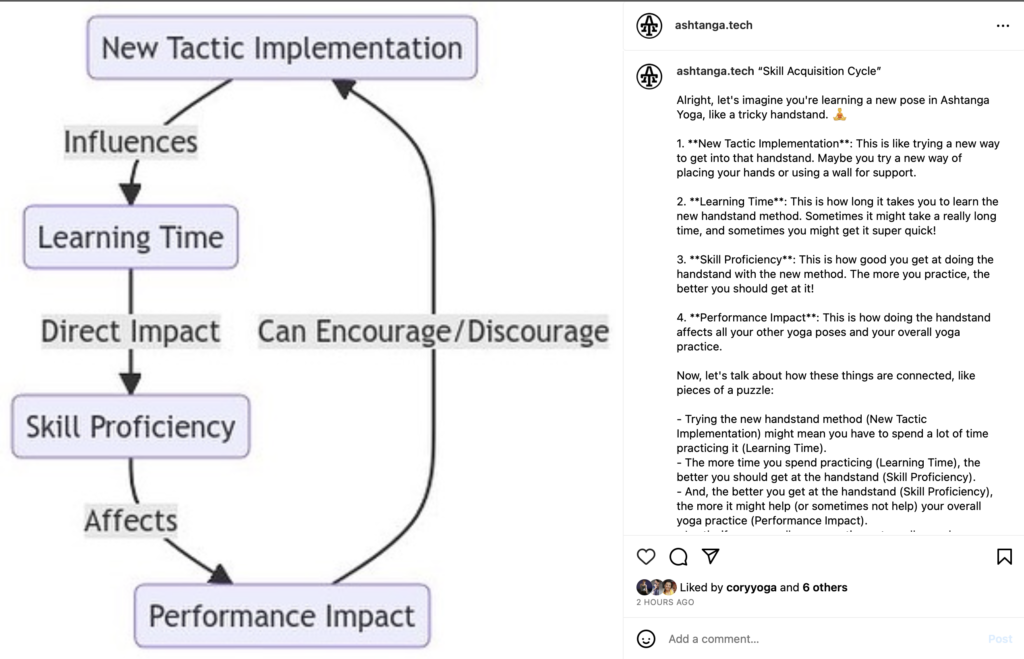
How to Make The Reality of Time Delays More Bearable
In these moments of entwined self-doubt and aspiration, reaching out for guidance becomes pivotal. However, articulating the need for help, especially when the path ahead is still shrouded in the mist of unfamiliarity, can be a journey in itself. Here are a few strategies tailored for Ashtanga practitioners on how to seek and articulate the need for assistance effectively:
1. Embrace Vulnerability:
- Acknowledge Limitations: Accept that being new to the practice means there’s a learning curve ahead.
- Be Open: Share your struggles and doubts with your teacher or fellow practitioners without fear of judgment.
2. Specificity in Questions:
- Identify Struggles: Pinpoint where you’re feeling most challenged, whether it’s a particular pose, sequence, or philosophical concept.
- Ask Targeted Questions: Seek clarity on specific aspects instead of general guidance.
3. Seek Personalized Guidance:
- Request One-on-One Time: If possible, ask your teacher for individual sessions to delve deeper into your unique challenges.
- Express Your Intent: Clearly communicate your willingness to learn and understand deeper aspects of the practice.
4. Engage in Community Practice:
- Join Group Sessions: Participate in classes or workshops where you can observe, learn, and ask questions in a collective setting.
- Connect with Peers: Sometimes fellow practitioners can offer insights from their own experiences and struggles.
5. Utilize Supplementary Resources:
- Explore Books and Online Platforms: Seek additional knowledge and perspectives from various resources.
- Apply Learnings: Bring questions from your readings to your teacher or practice group for further clarification.
6. Reflect and Journal:
- Maintain a Practice Diary: Note down your daily experiences, reflections, and areas of struggle on the mat.
- Review and Analyze: Periodically review your notes to understand patterns or recurring challenges in your practice.
8. Cultivate Patience and Compassion:
- Be Patient: Understand that mastery over Ashtanga Yoga unfolds over time and with consistent practice.
- Practice Self-Compassion: Honor your journey, acknowledging that every step, regardless of its size, is progress.
Navigating through the realms of Ashtanga Yoga, especially in the initial phases, is a delicate dance of seeking knowledge, understanding one’s own body and mind, and continuously evolving through practice. By embracing vulnerability, seeking guidance with specificity, and engaging deeply with the practice and community, you gradually unravel the layers, forging your unique path in the profound journey of Ashtanga Yoga.
After A While
Folks often forget how far they’ve come. Recency bias and negativity bias can create a perfect storm for forgetting the journey. “The Fitness Journey: A Tale of Unnoticed Progress” illustrates the subtle and often overlooked progress in consistent efforts, using the analogy of training for a marathon. Despite daily challenges and the illusion of stagnation due to recency bias, consistent training gradually enhances fitness levels, revealed only upon reflection or during unexpected moments of achievement, like completing a 10K run with ease. This concept parallels Ashtanga Yoga practice, where subtle, cumulative progress occurs over time, emphasizing the importance of consistency, a broad perspective, and recognizing and celebrating gradual advancements, even amidst apparent time delays and challenges.
The Fitness Journey: A Tale of Unnoticed Progress
Imagine you’ve embarked on a fitness journey. You’ve set a goal to run a marathon and have started training diligently. Every morning, you run a little bit, gradually increasing your distance and improving your stamina.
Immediate Response:
- Observation: Day-to-day, you don’t feel much difference. Some days are harder than others, and on days when you struggle, you might even feel like you’re regressing.
- Assumption (due to recency bias): Because of the challenges faced in the most recent runs, you might feel that you’re not making any significant progress. Recency bias makes you weigh your recent experiences more heavily than past ones, causing you to overlook the cumulative progress you’ve made.
Hidden Time Delay:
- Revelation: After several months, you decide to participate in a local 10K race as a practice run. To your surprise, you complete it with ease, and it dawns on you how far you’ve come since the start of your training.
- Secondary Realization: Looking back, you realize that while the day-to-day progress seemed minuscule, the cumulative effect over time was substantial. The time delay in recognizing this progress was due to the overshadowing effect of daily challenges and recency bias.
Systems Theory Perspective:
- Feedback Loop: The daily practice (running) created a positive feedback loop. Even though the immediate feedback after each run might have been mixed (due to varying daily performances), the overall system (your fitness level) was improving steadily.
- Adaptation: The system (your body) was adapting to the new conditions, building stamina and endurance. The time delay in recognizing this progress was due to the focus on immediate, recent experiences.
Relating to Ashtanga Yoga Practice:
- Subtle Progress: Just like the day-to-day progress in running might seem insignificant, the daily practice of Ashtanga yoga might also feel like it yields little immediate change. However, over time, the practitioner’s flexibility, strength, and mental clarity improve significantly.
- Understanding the System: An experienced yoga practitioner or teacher knows that progress is often subtle and cumulative. They understand the importance of consistent practice and the time delays inherent in recognizing significant improvements.
Lessons Learned:
- Consistency is Key: Even if immediate results aren’t visible, consistent effort over time leads to substantial progress.
- Broad Perspective: It’s essential to occasionally step back and assess progress from a broader perspective, rather than getting bogged down by recent challenges or setbacks.
This example illustrates how consistent effort, even if it seems to yield little immediate progress, can lead to significant positive outcomes over time. It emphasizes the importance of recognizing and celebrating the cumulative progress made over time, even if there are time delays in its realization due to recency bias or other factors.
Navigating with Intention
Embracing the journey, respecting the time delays, and immersing oneself into the process of learning and practicing Ashtanga Yoga is pivotal. Understanding and accepting time delays contributes to a sustainable and rewarding practice and fosters holistic development, aligning with the principles of both Ashtanga Yoga and systems theory. Holistic development, which encompasses physical, mental, and spiritual growth, becomes a natural byproduct of a practice that is approached with understanding, respect for time delays, and a commitment to consistent, mindful practice. It ensures that the practitioner’s journey through Ashtanga Yoga is not merely a physical endeavor but a pathway that nurtures growth, stability, and mastery in every facet of their being.
1. Setting Micro-Goals:
- Achievable Targets: Establish small, attainable goals within the practice to celebrate minor achievements and stay motivated.
- Progress Tracking: Utilize tools or journals to track these micro-goals and visualize subtle advancements.
2. Embracing the Process:
- Enjoy the Journey: Find joy in the daily practice itself, rather than being fixated on mastery or end goals.
- Celebrate Small Wins: Acknowledge and celebrate every small milestone, even if it’s just being consistent with practice.
3. Educational Workshops:
- Understanding the Practice: Attend workshops that delve into things that match your micro-goals, as well as those focused on the deeper layers of Ashtanga yoga. so rarely are people too worried about being nice enough. Mostly it’s physical.
- Learning Patience: Engage in sessions that specifically address the concepts of periodization and sequencing. Get a realistic idea of how long something takes to learn.
4. Rest and Recovery:
- Scheduled Rest Days: Ensure to incorporate rest days to allow the body to recover and adapt.
- Mindful Rest: Engage in restorative practices like meditation or Yin Yoga to balance the rigorous Ashtanga practice. Don’t skip a moon day!
5. Adjusting Expectations:
- Realistic Outlook: Cultivate a realistic understanding of progress and mastery in Ashtanga Yoga.
- Flexible Approach: Be willing to adjust goals and practices based on the body’s feedback and overall progress.
6. Diversifying Practice:
- Incorporate Variety: Occasionally integrating other forms of movement or yoga can provide fresh insights and prevent burnout.
- Explore Different Aspects: Dive into the philosophical and meditative aspects of yoga to enrich and diversify the practice.
7. Continuous Learning:
- Read and Explore: Engage with literature and resources that delve into the intricacies of yoga and personal development.
- Workshops and Courses: Enroll in courses that explore deeper aspects of yoga, enhancing understanding and appreciation of the practice.
8. Mindset Work:
- Growth Mindset: Cultivate a mindset that embraces challenges as opportunities for growth.
- Positive Affirmations: Utilize affirmations to instill a positive and patient approach towards practice.

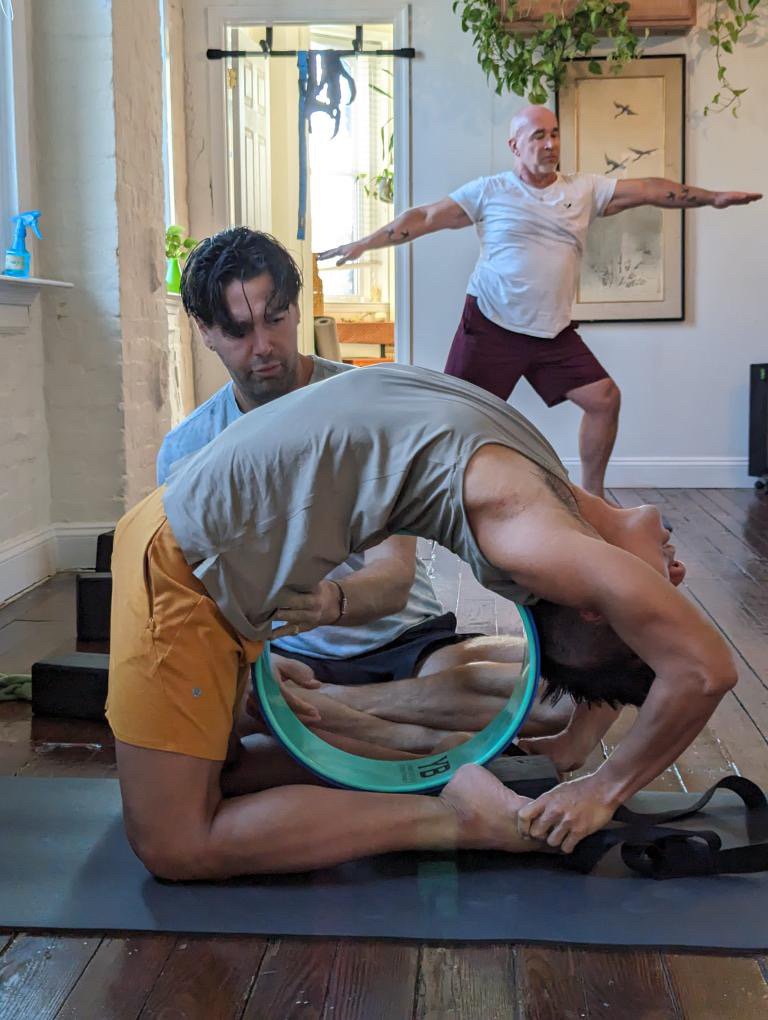
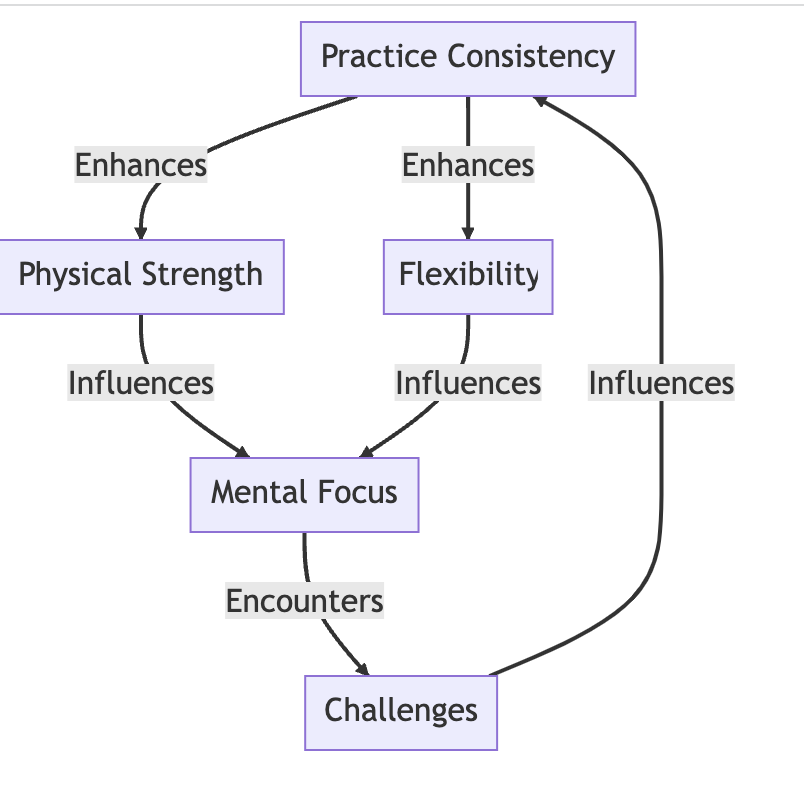




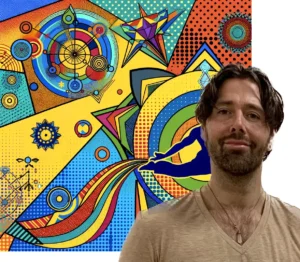

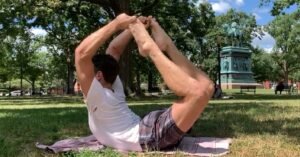
[…] Understanding Time Delays in Ashtanga Yoga: A Systems Thinking Perspective […]
[…] Understand that progress in Ashtanga yoga doesn’t happen overnight. It’s a gradual process that unfolds uniquely for each individual [5]. […]
[…] Understand that progress in Ashtanga yoga doesn’t happen overnight. It’s a gradual process that unfolds uniquely for each individual [5]. […]
[…] Understand that progress in Ashtanga yoga doesn’t happen overnight. It’s a gradual process that unfolds uniquely for each individual [5]. […]